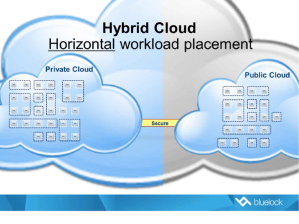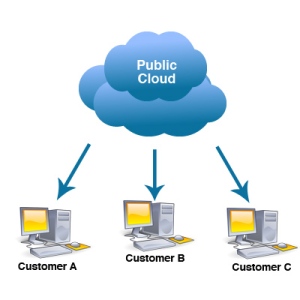With public and private clouds, the customer could enjoy the services of
infrastructure deployed at provider location. If the customer is
looking for another infrastructure then they have to look for another
provider, or the provider could actually resell the infrastructure of
another provider, clouds do not aggregate infrastructures to
build up larger, cross-boundary structures. Smaller enterprises took
benefit by deploying clouds as community clouds. Here different entities
contribute with their respective (smaller) infrastructure. Community
clouds can either aggregate public clouds or dedicated resource
infrastructures, i.e. smaller organizations may come together only to
pool their resources for building a private community cloud.
Breaking News
Monday 24 February 2014
Hybrid Clouds
Hybrid clouds comes in flavor of both private and public cloud
infrastructures so as to achieve high reliability and a maximum of cost
reduction through outsourcing and simultaneously maintaining desired
degree of control over it. For example critical information can be
employed over local private clouds. Within this model, a public cloud is
leveraged to extend or supplement an internal cloud. For example, a
company may employ an internal cloud to share physical and virtual
resources over a network, but extend these capabilities when needed such
as at peak processing times.
Pros and Cons
A mixed cloud infrastructure model supports high capacity time periods and mitigates security risks on mission critical applications. It enables you to leverage the advantages of public cloud for more portable and appropriate applications, while maintaining control over legacy and vital systems with greater compliance, performance, and security requirements. The hybrid model also provides an optimal approach for architecture since organizations can combine local infrastructure with infrastructure that is scalable and provisioned on demand. A mixed model offers cost saving and provisions unlimited flexibility. It provides the solution for the problem raised due to elasticity. Because of these considerable advantages, a hybrid cloud model is likely to be the most widely adopted
Cons in this model include the complexity of managing and monitoring the infrastructure in the cloud from a common portal or service desk. Automation at all the portions of the hybrid cloud is complex. This requires considerable engineering on the part of the IT organization or the acquisition of third-party vendor services to provide the necessary “glue” to oversee the enterprise environment wealth of information on how to enhance their business value while reducing costs and freeing resources for more strategic initiatives.
Pros and Cons
A mixed cloud infrastructure model supports high capacity time periods and mitigates security risks on mission critical applications. It enables you to leverage the advantages of public cloud for more portable and appropriate applications, while maintaining control over legacy and vital systems with greater compliance, performance, and security requirements. The hybrid model also provides an optimal approach for architecture since organizations can combine local infrastructure with infrastructure that is scalable and provisioned on demand. A mixed model offers cost saving and provisions unlimited flexibility. It provides the solution for the problem raised due to elasticity. Because of these considerable advantages, a hybrid cloud model is likely to be the most widely adopted
Cons in this model include the complexity of managing and monitoring the infrastructure in the cloud from a common portal or service desk. Automation at all the portions of the hybrid cloud is complex. This requires considerable engineering on the part of the IT organization or the acquisition of third-party vendor services to provide the necessary “glue” to oversee the enterprise environment wealth of information on how to enhance their business value while reducing costs and freeing resources for more strategic initiatives.
Public Clouds
Public Clouds are owned by the cloud vendors, the computing
infrastructures are hosted at the vendor’s premises. In this kind of
deployment Cloud is made available in pay-as-you-go manner to the
general public. The customer has no visibility of where the computing
infrastructure is hosted.
The customer experiences the service as if the resources are used from their desktop and are abstracted from how cloud works. The cloud resources are shared among multiple customers, cloud providers offer a variety of options in pricing, performance, and feature set. With public clouds the customer can use only or any of the services provided by cloud, services may be AaaS, SaaS, PaaS or IaaS. Customer need not worry about the infrastructure to be setup or need not pay a large upfront cost (e.g., for hardware cost) before purchasing any services nor over-provision resources to accommodate future or peak demand.
A primary benefit of going for public cloud is economics. Since they are by necessity, optimized for minority peak-load times, data centers are underutilized the majority of the time. Even the customer has no hassle of looking out for extra capacity of servers or apply a thought on cost cutting measures, nor think about maintaining and dealing with wear and tear of infrastructure. The public can go green by preserving the nature’s gifts by using resources as needed. Since power, cooling and physical plant costs are reduced, low operations costs.
A growing number of companies are riding this wave to provide public cloud computing services, such as Amazon, Google, Microsoft, Rackspace, and GoGrid & many more google it. A well-known consumer version of a public cloud application is the iTunes Store.
Pros and Cons
Public Cloud is a low cost option for customers since it is a shared capability. It provides an ideal platform for rapid proofs of concept, on-demand performance testing, and document and information collaboration through technologies such as Google Doc’s, docstoc.com, Flicker.com. The major downside of this cloud computing model is the location and security of proprietary information. Public cloud offerings are essentially public (rather than private) networks, exposing the system to more attacks. One issue is that vendor cloud administrators have access to data creating theft or abuse risks. The location of data is also of great consequence since it determines under which laws the information resides. Another major concern is data recovery. Most public cloud servers are not built for high availability or automatic failover. As a result, enterprises may be forced to spend additional monies for a backup or failover environments. In addition, because of the utility nature of the public cloud model, vendors cannot provide meaningful Service Level Agreements.
The customer experiences the service as if the resources are used from their desktop and are abstracted from how cloud works. The cloud resources are shared among multiple customers, cloud providers offer a variety of options in pricing, performance, and feature set. With public clouds the customer can use only or any of the services provided by cloud, services may be AaaS, SaaS, PaaS or IaaS. Customer need not worry about the infrastructure to be setup or need not pay a large upfront cost (e.g., for hardware cost) before purchasing any services nor over-provision resources to accommodate future or peak demand.
A primary benefit of going for public cloud is economics. Since they are by necessity, optimized for minority peak-load times, data centers are underutilized the majority of the time. Even the customer has no hassle of looking out for extra capacity of servers or apply a thought on cost cutting measures, nor think about maintaining and dealing with wear and tear of infrastructure. The public can go green by preserving the nature’s gifts by using resources as needed. Since power, cooling and physical plant costs are reduced, low operations costs.
A growing number of companies are riding this wave to provide public cloud computing services, such as Amazon, Google, Microsoft, Rackspace, and GoGrid & many more google it. A well-known consumer version of a public cloud application is the iTunes Store.
Pros and Cons
Public Cloud is a low cost option for customers since it is a shared capability. It provides an ideal platform for rapid proofs of concept, on-demand performance testing, and document and information collaboration through technologies such as Google Doc’s, docstoc.com, Flicker.com. The major downside of this cloud computing model is the location and security of proprietary information. Public cloud offerings are essentially public (rather than private) networks, exposing the system to more attacks. One issue is that vendor cloud administrators have access to data creating theft or abuse risks. The location of data is also of great consequence since it determines under which laws the information resides. Another major concern is data recovery. Most public cloud servers are not built for high availability or automatic failover. As a result, enterprises may be forced to spend additional monies for a backup or failover environments. In addition, because of the utility nature of the public cloud model, vendors cannot provide meaningful Service Level Agreements.
Private Clouds
Private Clouds are enterprise-clouds which are owned by the
organizations and the computing infrastructure is dedicated to the
organizations and the services are not availed to the external users or
other organizations, hence private clouds are also referred as internal
clouds. Private clouds are considered to be more secure than any other
types of deployments of clouds, since the services offered by the
private clouds restricts its usage only to the organization users, and
attacks from external network is filtered at the first step.
Proportionately private clouds are more expensive. Since clouds should
meet the criteria of elasticity, platform infrastructure, hardware
infrastructure must be redundantly available and scalable than required.

Further private clouds can be of two types: On premise private clouds and externally hosted private clouds. Externally hosted private clouds are not hosted in-house by the organization; instead they are hosted by the third party cloud provider, and are exclusively used by particular organizations in cloud infrastructure. As opposed to expense, externally hosted private clouds are cheaper and little less secure than on premise private clouds.
Pros and Cons
Major issue with development of private clouds consists in vendor lock-in [2]. As most commercial tools were developed independently from one another with a particular focus on solving the respective company’s customers’ problems first, there is little (technical) convergence between the available products. This is also due to the typical development cycle of clouds which typically start as in-house, internal solutions (private clouds) which are then extended to provide (a subset of) capabilities to potential customers (public clouds).
On the other hand the providers will initially want to make use of private clouds and employ for long run will employ so as to address the issues of control versus cost. In combination with the issue of legislation and data distribution, this builds a requirement for industry to have cloud technologies and infrastructures being disposed within required regional or geographical boundaries, so as to ensure that data can remain within a legislative area, if required. This expertise and capability will prove particularly useful to build up new global policies and regulate cloud specific legislations.
Similarly, this knowledge can be employed to provide the environment into new business models and expertise to ensure economic value creation from the employment of cloud systems for various use cases. This information can be used for new systems that automate the cloud configuration even more efficiently. The issue implicitly relates to aspects of Green IT, which currently has found little support in cloud systems, but is a significant issue in current data centre design.
Private Clouds can be thought of to be hosted by an external private cloud provider due to the following reasons

Further private clouds can be of two types: On premise private clouds and externally hosted private clouds. Externally hosted private clouds are not hosted in-house by the organization; instead they are hosted by the third party cloud provider, and are exclusively used by particular organizations in cloud infrastructure. As opposed to expense, externally hosted private clouds are cheaper and little less secure than on premise private clouds.
Pros and Cons
Major issue with development of private clouds consists in vendor lock-in [2]. As most commercial tools were developed independently from one another with a particular focus on solving the respective company’s customers’ problems first, there is little (technical) convergence between the available products. This is also due to the typical development cycle of clouds which typically start as in-house, internal solutions (private clouds) which are then extended to provide (a subset of) capabilities to potential customers (public clouds).
On the other hand the providers will initially want to make use of private clouds and employ for long run will employ so as to address the issues of control versus cost. In combination with the issue of legislation and data distribution, this builds a requirement for industry to have cloud technologies and infrastructures being disposed within required regional or geographical boundaries, so as to ensure that data can remain within a legislative area, if required. This expertise and capability will prove particularly useful to build up new global policies and regulate cloud specific legislations.
Similarly, this knowledge can be employed to provide the environment into new business models and expertise to ensure economic value creation from the employment of cloud systems for various use cases. This information can be used for new systems that automate the cloud configuration even more efficiently. The issue implicitly relates to aspects of Green IT, which currently has found little support in cloud systems, but is a significant issue in current data centre design.
Private Clouds can be thought of to be hosted by an external private cloud provider due to the following reasons
- If demand for service varies with time, i.e. demand is unknown at times.
- Provisioning a data center for the peak load
- To avoid underutilization.
- Support and constant maintenance.
Cloud Deployment Types
Deployment of Clouds varies on the type of user groups, scale of
users using the clouds, constraints on the usage of resources, usage in
terms as internal and external activities within and outside
organizations.
 I would like to put forth an anecdoe
on how tyre tubes evolved. The incident can be narrated as follows. In
late 18th century, a Doctor named Mr. Dunlop was busy with his research
and serving to his patients, but he was being troubled by the noise
generated by his son when he used to ride the bicycle.
I would like to put forth an anecdoe
on how tyre tubes evolved. The incident can be narrated as follows. In
late 18th century, a Doctor named Mr. Dunlop was busy with his research
and serving to his patients, but he was being troubled by the noise
generated by his son when he used to ride the bicycle.
This made Dr. Dunlop annoyed, to get rid of the sound generated by the tyre-less bicycle, he took the rubber hose and tied to the circumference of the bicycle iron-wheel, this brought him great relief and got rid of the unwanted noise. Later he came forward and applied this idea in mass generation of tubes for vehicle tyres. Thus now the world moves in air even on uneven land.
 The
saying goes true that necessity is the mother of all inventions and
innovations. Private organizations built up clouds to evolve internal
solutions (private clouds) to manage the local infrastructure and the
amount of requests e.g. to ensure availability of highly requested data.
The computation varied according to the request generated. The
resources were not fully utilized all the time. This is due to the fact
that data centers initiating cloud capabilities made use of these
features for internal purposes. Later the organizations extended the
interests by considering selling the capabilities publicly (public
clouds). This brought the providers gain confidence in publication and
exposition of cloud features. This movement from private via public to
combined solutions is often considered a “natural” evolution of Hybrid
systems, though there is no reason for providers to not start up with
hybrid solutions, once the necessary technologies have reached a mature
enough position.
The
saying goes true that necessity is the mother of all inventions and
innovations. Private organizations built up clouds to evolve internal
solutions (private clouds) to manage the local infrastructure and the
amount of requests e.g. to ensure availability of highly requested data.
The computation varied according to the request generated. The
resources were not fully utilized all the time. This is due to the fact
that data centers initiating cloud capabilities made use of these
features for internal purposes. Later the organizations extended the
interests by considering selling the capabilities publicly (public
clouds). This brought the providers gain confidence in publication and
exposition of cloud features. This movement from private via public to
combined solutions is often considered a “natural” evolution of Hybrid
systems, though there is no reason for providers to not start up with
hybrid solutions, once the necessary technologies have reached a mature
enough position.
We can hence distinguish between the following types of deployment of Clouds [2]:
i. Private Clouds
ii. Public Clouds
iii. Hybrid Clouds
iv. Community Clouds
[Reference : Report, Expert Group. The Future of Cloud Computing 2010 . s.l. : Commission of the European Communities, Information Society & Media., 2010. Public version 1.0 .]
 I would like to put forth an anecdoe
on how tyre tubes evolved. The incident can be narrated as follows. In
late 18th century, a Doctor named Mr. Dunlop was busy with his research
and serving to his patients, but he was being troubled by the noise
generated by his son when he used to ride the bicycle.
I would like to put forth an anecdoe
on how tyre tubes evolved. The incident can be narrated as follows. In
late 18th century, a Doctor named Mr. Dunlop was busy with his research
and serving to his patients, but he was being troubled by the noise
generated by his son when he used to ride the bicycle. This made Dr. Dunlop annoyed, to get rid of the sound generated by the tyre-less bicycle, he took the rubber hose and tied to the circumference of the bicycle iron-wheel, this brought him great relief and got rid of the unwanted noise. Later he came forward and applied this idea in mass generation of tubes for vehicle tyres. Thus now the world moves in air even on uneven land.
 The
saying goes true that necessity is the mother of all inventions and
innovations. Private organizations built up clouds to evolve internal
solutions (private clouds) to manage the local infrastructure and the
amount of requests e.g. to ensure availability of highly requested data.
The computation varied according to the request generated. The
resources were not fully utilized all the time. This is due to the fact
that data centers initiating cloud capabilities made use of these
features for internal purposes. Later the organizations extended the
interests by considering selling the capabilities publicly (public
clouds). This brought the providers gain confidence in publication and
exposition of cloud features. This movement from private via public to
combined solutions is often considered a “natural” evolution of Hybrid
systems, though there is no reason for providers to not start up with
hybrid solutions, once the necessary technologies have reached a mature
enough position.
The
saying goes true that necessity is the mother of all inventions and
innovations. Private organizations built up clouds to evolve internal
solutions (private clouds) to manage the local infrastructure and the
amount of requests e.g. to ensure availability of highly requested data.
The computation varied according to the request generated. The
resources were not fully utilized all the time. This is due to the fact
that data centers initiating cloud capabilities made use of these
features for internal purposes. Later the organizations extended the
interests by considering selling the capabilities publicly (public
clouds). This brought the providers gain confidence in publication and
exposition of cloud features. This movement from private via public to
combined solutions is often considered a “natural” evolution of Hybrid
systems, though there is no reason for providers to not start up with
hybrid solutions, once the necessary technologies have reached a mature
enough position.We can hence distinguish between the following types of deployment of Clouds [2]:
i. Private Clouds
ii. Public Clouds
iii. Hybrid Clouds
iv. Community Clouds
[Reference : Report, Expert Group. The Future of Cloud Computing 2010 . s.l. : Commission of the European Communities, Information Society & Media., 2010. Public version 1.0 .]
Sunday 23 February 2014
How to change Project Facet in Eclipse
This post is about how to change version of project facet Dynamic Web Module to 3.0 or any other in Eclipse!
Open web.xml from project structure
<web-app xmlns="http://java.sun.com/xml/ns/javaee" xmlns:xsi="http://www.w3.org/2001/XMLSchema-instance"
xsi:schemaLocation="http://java.sun.com/xml/ns/javaee
http://java.sun.com/xml/ns/javaee/web-app_3_0.xsd"
version="3.0">
<display-name>Servlet 3.0 Web Application</display-name>
</web-app>and update web.xml file
for example change version = "2.5"
Also change the org.eclipse.wst.common.project.facet.core.xml file from your project .settings file
Follow the steps
1. Window > Show View > Other > General > Navigator
2. There is a .settings folder under your project directory
3. Change the dynamic web module version in this line to 2.5
4.Change the Java version in this line to 1.5 or higher
Now refresh your project and get set to run on your server.
Labels:
Eclipse,
J2ee project,
Project Facet,
Server
Subscribe to:
Posts (Atom)



